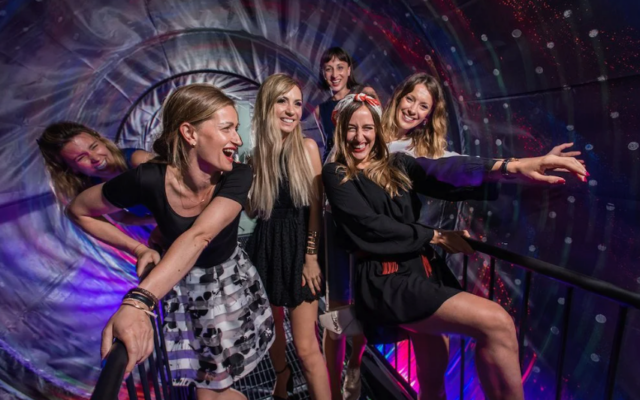New Museum of Illusions Challenges the Mind
The latest addition to the Atlantic Station complex offers an “edutainment” experience that questions how we encounter our vision of the world.

Parents looking for an opportunity to provide their children with a summertime recreational experience that is educational at the same time now have a new option.
It’s the Museum of Illusions which opened in April in the heart of the Atlantic Station shopping complex. The 10,000-square-foot attraction, which is part of a fast-growing, international network of locations, provides visitors with a new way of looking at the world by exploring the science of optics and the way our eyes can sometimes play tricks on us.
The CEO of the company, which is described as the largest and fastest growing chain of privately owned museums in the world, is Jonathan Benjamin. Benjamin, who runs the operation from its international headquarters in Atlanta, believes that exhibits that explore the science of how we see the world can sometimes be just as exciting as the latest theme park gadgetry.
“Our museums are about exploring the unexpected. It’s about the ways our perception of reality can play tricks on us,” Benjamin notes. “Some of these exhibits are based on principles that are centuries old, and yet, they’re still mind bending. It’s not something electronic that exists on a computer server, it’s right there before your very eyes. And the challenge we present to people is to reconcile what it is you’re seeing with reality.”

One example in the museum is the Ames Room that may appear, at first glance, to be an ordinary rectangular cube, but it’s actually an irregular geometric shape that is described as trapezoidal. One corner of the room is actually much closer to the observer than an opposing corner. Because it plays with our mental idea of perspective, a person in one corner of the room may appear to be much larger or much smaller than another.
The Ames Room is based on the work of the American scientist Adelbert Ames, who was a research professor at Dartmouth College in Massachusetts. His work on how our mind tricks us into believing, which was first published over 75 years ago, was about how the mind can sometimes process visual impressions to make us believe that ideas about depth and shape and size are more real than they actual are. The implications of his research were to raise questions about the validity of what we sometimes describe as eyewitness reports.
Later research by David Hubel and Torsten Wiesel at Harvard University, about how the brain processes the information from optical illusions, won the 1981 Nobel Prize in medicine.

Another example of how our brain can sometimes become confused about what we’re seeing is the Vortex Tunnel at the Museum of Illusions. The tunnel has a bridge which is stable, but it is surrounded by a cylinder that is spinning. Stepping onto the bridge creates the impression that the bridge is spinning and not the cylinder. Your brain, which is presented with so much information at one time, is seemingly overwhelmed. It can’t, in effect, believe what your eyes are seeing.
All this visual sleight of hand has paid off handsomely for the two Serbians who founded the first Museum of Illusion in Zagreb in 2015. Their RP Illusions Corporation, which developed the museums, was boosted two years ago by a substantial investment from a venture capital firm, Invera Equity Partners, which is based in the Netherlands.
The company’s growth, however, is no illusion. It now has 45 museums in 21 countries, including one in Tel Aviv. With the worldwide pandemic receding in memory, growth is expected to be robust in the years ahead. Earlier in 2023, they opened in Scottsdale, Ariz., and Austin, Texas, and just this week they cut the ribbon in Montreal. Up next is a 16,000-square-foot location on the Las Vegas Strip.
The rapid expansion is keeping Benjamin on a tight travel schedule in and out of Hartsfield-Jackson International Airport. He’s lived here since his work in the franchise industry first brought him to Atlanta in 1998. The Jewish museum executive, however, claims no kinship with Judah Benjamin, the Confederate Secretary of the Treasury who was also Jewish. The latter had his hands full during the Civil War full trying to dispel any illusions, at the time, that the South could survive financially.
Although Benjamin expects the new flagship location here to attract tourists and conventioneers, he’s counting on much of the business to come from the local community. He believes that the museum provides a good opportunity for what is described as an “edutainment” experience for schools, youth groups, and families.
“The overwhelming majority of our locations are expected to integrate with the community as a whole,” Benjamin says. “So, we’ve got a 10-year lease or more in all of our locations. We expect that most of our customers here will be Atlantans.”
- Arts and Culture
- Local
- Bob Bahr
- Museum of Illusion
- Atlantic Station
- Jonathan Benjamin
- REALITY
- optical illusion
- Ames Room
- Adelbert Ames
- Dartmouth College
- David Hubel
- Torsten Wiesel
- Harvard University
- Vortex Tunnel
- RP Illusions Corporation
- Invera Equity Partners
- Hartsfield Jackson International Airport
- Judah Benjamin
- Confederate Secretary of the Treasury
- museum of illusions



comments